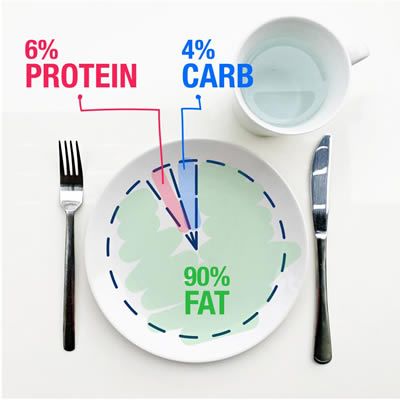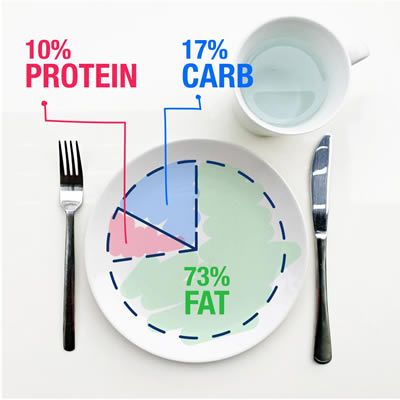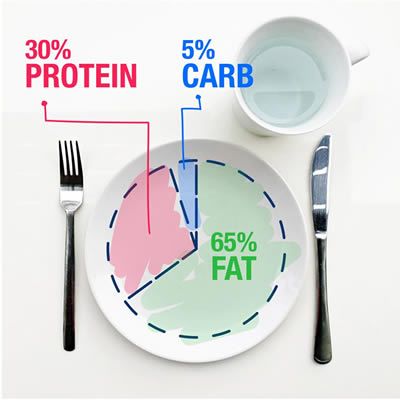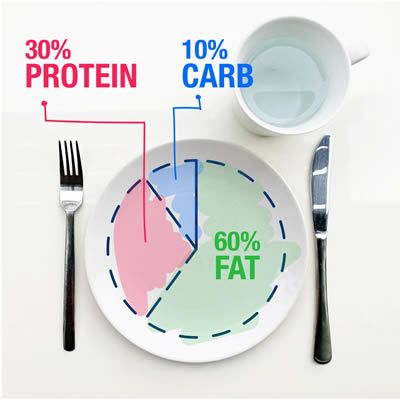by Danielle Dunn
The essence of the ketogenic diet is that fat is by far the main source of calories.
This flips the old school food pyramid we grew up with on its head. You know the picture recommending something like 6-8 servings of bread, pasta and cereals on the bottom and only a tiny amount of oil, cream and butter on the top each day with veges, fruit, meat and eggs in the middle. Forget that! Get rid of the bottom section of the pyramid then flip it upside down with the fat being the biggest portion and that is closer to what the ketogenic diet looks like.
You may be more familiar with the Ketogenic Diet being a trendy method for weight loss...
You may be more familiar with the Ketogenic Diet being a trendy method for weight loss and general wellness. Ketogenic Therapy for epilepsy pushes the diet much further than what you will see celebritities doing in the magazine section at the supermarket. The 'fashionable' weight loss form of the ketogenic diet is typically 50-60% fat. In contrast, under the meticulous guidance of a specialised Ketogenic Dietitian you will be prescribed a precisely formulated individualised diet plan depending on your epilepsy presentation of up to 90% fat.
Traditionally the proportions in calories of the Classic Ketogenic Diet have been 90% fat, 6% protein and 4% carbohydrate. In more recent times it has been shown that other proportions can be effective in some patients too. The following diagrams are adapted from American ketogenic organisation, the Charlie Foundation. Check them out here: https://charliefoundation.org/diet-plans/
TYPES OF KETOGENIC DIET PLANS
Classic Ketogenic
This is the strictest form of the diet and is most often used in children and older patients who do not respond to lower fat variations of the ketogenic diet. Recipes must be formulated to calculate every ingredient in each meal down to 0.1 of a gram and every meal is weighed out as calories are controlled.
The ratio of the Classic Ketogenic Diet is commonly around 4 parts calories in fat to 1 part calories in combined protein and carbohydrate (4:1). Personalised food prescription variations exist for everything between 4:1 to 1:1 ratios of fat to combined protein and carbohydrate which are used when starting or weaning the diet to see what ratio works best for the individual patient.
Ketogenic Therapy is not a quick fix. A commitment of 3-6 months is required to assess whether the patient will respond adequately to the diet. Patients typically stay on the diet for at least 2 years before weaning to a less restricted version of the diet or back to their regular diet depending on their seizure control.
Much skill is involved on the Dietitian's part in precisely formulating a Classic Ketogenic prescription and tailoring it to the individual patient depending on their response. Equally a huge amount of dedication by the family goes into following the classic ketogenic diet correctly. Fortunately with the advances in technology special Keto Calculators help to formulate recipes which would have otherwise been calculated by hand in the past. There are many great recipes available for use that can serve as a starting point and recalculated to the individual patient's requirements.

MCT (medium chain triglyceride) Oil Diet
MCT oil produces ketones more readily than longer chain fats and therefore a smaller amount of fat is required to maintain ketosis than that in the Classical Ketogenic Diet if MCT oil is included in each meal. This means the remainder of the diet can be filled with larger amounts of carbohydrate and protein than the Classical Ketogenic Diet, allowing for more flexibility with meal planning. MCT oil formulations are available on prescription. Coconut oil is made up of around 50% MCT oil. MCT oil needs to be introduced gradually as it can cause tummy upsets.
Like the Classic Ketogenic Diet, ingredients need to be weighed out carefully and calories controlled. MCT oil is specified by the Registered Dietitian separately as part of your Food Prescription.

Modified Atkins Diet
The Atkins Diet is known widely as a high protein low carbohydrate diet. In the Ketogenic scene it is modified to encourage an ample fat allowance and to minimise the carbohydrate content. A much greater allowance of protein is permitted than that for the Classic Ketogenic Diet. On this diet only the carbohydrates are carefully counted, fat is encouraged with each meal and protein is freely allowed. Calories are not restricted and besides keeping the carbohydates limited, ingredients do not have to be as carefully measured as that for the Classic or MCT oil diets. This is a more manageable diet for teens and adults who may have difficulty complying with the rigidity of the classic ketogenic diet.

Low Glycaemic Index Treatment (LGIT)
The Glycaemic Index (GI) is a number between 0-100 which measures the ability of each type of food to raise the blood sugar levels 2 hours after eating. Foods which have a value under 50 are considered to be low GI foods. This diet restricts the total amount of carbohydates and the types of foods to ensure only low GI foods are eaten. The diet is more relaxed than the Classic Ketogenic Diet as care needs to be taken in selecting and counting out the carbohydrates each day but fat and protein amounts can be estimated. The diet is a bit different than the other types of Ketogenic Diets as it is focussed more on keeping blood sugar levels stable rather than inducing Ketosis.

Important Note
All ketogenic diets are nutritionally incomplete!
All ketogenic diets are nutritionally incomplete, especially for growing children and they all have the risk of side effects so supervision by a specialised Registered Dietitian and Neurologist is paramount to carry out the diet correctly and safely. The interplay between Ketogenic Therapy and seizure control is highly individualised and requires a lot of fine tuning. To get the best out of the commitment you put into Ketogenic Therapy ensure you select support from a dietitian who is trained and experienced in every type of Ketogenic Diet and is backed up by your Neurologist.